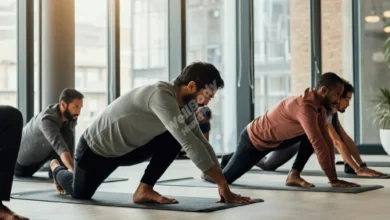Seasonal Yoga Practices: Aligning Your Yoga with Nature

As we move through the ever-changing cycles of the seasons, aligning our yoga practice with the natural world around us can bring a deeper sense of connection and harmony. By tuning into the energies of each season, we can tailor our yoga routines to better support our well-being and overall balance. Let’s explore how you can incorporate seasonal yoga practices into your daily routine and reap the benefits of aligning your practice with nature.
1. Spring Renewal: Awakening and Growth
Spring is a time of renewal and growth, making it the perfect season to focus on energizing and invigorating yoga practices. Poses that open the heart and stimulate circulation can help shake off the heaviness of winter and welcome the fresh energy of spring. Consider incorporating dynamic flows and twists into your routine to detoxify the body and awaken your spirit.
2. Summer Vitality: Harnessing the Sun’s Energy
Summer is a season of vitality and abundance, characterized by the sun’s warmth and brightness. To align your yoga practice with summer, focus on poses that build heat and strength, such as Sun Salutations and standing poses. Embrace the fiery energy of summer by practicing in the early morning or evening when the sun is less intense. Below is a table outlining some summer yoga poses to incorporate into your practice:
| Summer Yoga Poses | Benefits |
|---|---|
| Warrior II | Strengthens legs and core |
| Boat Pose | Engages abdominal muscles |
| Camel Pose | Opens the heart chakra |
3. Autumn Grounding: Cultivating Stability
Autumn brings a sense of grounding and introspection as nature prepares for the coming winter. This season is an ideal time to focus on balancing poses that root you to the earth, such as Tree Pose and Warrior III. Incorporate forward folds and gentle twists to release any stagnant energy and create space for introspection and inner growth. To enhance your autumn practice, consider incorporating the following breathing techniques:
- Nadi Shodhana (Alternate Nostril Breathing)
- Ujjayi Breath (Victorious Breath)
4. Winter Rest: Nurturing and Restoring
Winter invites us to turn inward, slow down, and nurture ourselves. Embrace restorative yoga practices that promote relaxation and rejuvenation, such as supported child’s pose and reclining bound angle pose. Focus on deep breathing and mindfulness to cultivate a sense of inner peace and contentment during the colder months. Remember to listen to your body and give yourself permission to rest and restore.
5. Aligning Your Practice: Tips for a Harmonious Yoga Routine
To align your yoga practice with the changing seasons, consider the following tips:
- Stay attuned to your body’s needs and energy levels
- Modify your practice based on the season and your own internal rhythms
- Incorporate mindfulness and gratitude into each practice
- Connect with nature by practicing outdoors when possible
6. FAQ: Seasonal Yoga Practices
Q: How can seasonal yoga practices benefit my overall well-being?
A: Seasonal yoga practices can help you align with the natural rhythms of the world around you, promoting balance, vitality, and harmony in both body and mind.
Q: Should I adjust my yoga practice throughout the year?
A: Yes, adapting your yoga practice to the changing seasons can support your well-being by providing the specific nourishment and energy needed during each time of year.
7. Key Takeaways
Incorporating seasonal yoga practices into your routine can deepen your connection with nature, promote balance and well-being, and provide a sense of harmony throughout the year. By aligning your practice with the changing seasons, you can tap into the transformative power of nature and cultivate a more holistic and fulfilling yoga experience. Remember to listen to your body, honor the rhythms of the natural world, and embrace the ever-evolving journey of your yoga practice.



